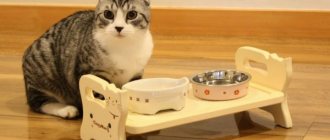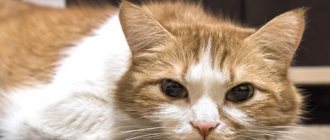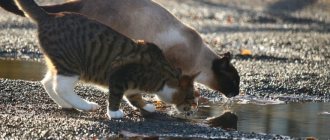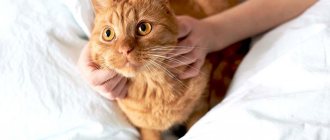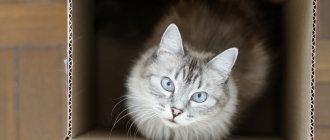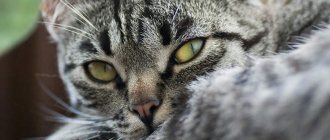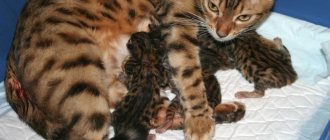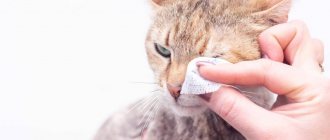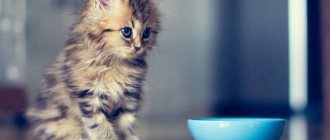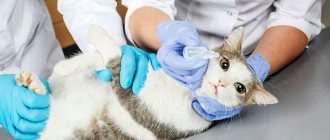How old is your pet?
Ten? More? Then this is definitely the place for you! Because after 8-10 years, various age-related changes begin to occur in the cat’s body, which you need to be aware of and take into account. May your four-legged pet live happily ever after! By the way, previously the age limit for our pets was much lower - 12-year-old cats were considered long-livers. It was man who raised the quality of life, and with it its duration, by one and a half to two times.
And now it is easy to meet cats that have reached 16-19 years of age, or even more. For example, in our clinic we see two cats, each 21 years old, and the most significant thing that worries them is their teeth, or rather, tartar, which is removed from them from time to time.
Well, the age of cats from the Guinness Book of Records generally exceeds the 30-year mark.
So, among pets, the number of “elderly” pets (approximately 30%) who need optimal care is increasing.
It’s a fact that as the number of years you live increases, everything changes (and not only for cats :-)). Age-related changes affect all body functions. For now, we will consider only behavioral ones.
The causes of behavioral changes can be a number of diseases (including systemic ones) acquired by the animal over the years of its life, brain pathologies, as well as CDS - cognitive dysfunction syndrome. First, let's look at medical ailments, and then move on to the most interesting part.
Osteoarthritis (joint disease) can occur in 65% of cats over 12 years of age (the elbow and hip joints are most commonly affected, and the knee and shoulder are less common). Joint pain leads to decreased mobility and the appearance of aggressiveness when communicating with people and other animals.
Systemic hypertension (high blood pressure) often causes a pet to scream at night, disorientate in space, lose consciousness, meaningless circular movements and even seizures.
Chronic kidney disease most strongly influences behavior changes: polyuria (increased urine volume) leads to urination in the wrong places, and with a lack of water, dehydration of brain tissue. Polydipsia (increased thirst) causes cats to drink from containers that are not intended for this purpose. The development of acidosis (increased body acidity) causes weight loss and drowsiness. And severe uremia (self-poisoning of the body with nitrogenous waste from urine) leads to uremic encephalopathy, a non-inflammatory disease of the brain. In addition, kidney disease is often accompanied by hypertension (see above).
Hyperthyroidism (increased thyroid hormones) leads to the same consequences as chronic renal failure. In addition, it affects the concentration of thyroxine in the brain (manifests as anxiety and aggressiveness), causes polyphagia - the cat’s taste and appetite change.
Diabetes mellitus has the same consequences as chronic renal failure and hyperthyroidism. In addition, it can cause sensory or motor neuropathies (irritability, increased sensitivity to external influences (touch), muscle pain).
Urinary tract infections cause pain and discomfort in your pet's bladder or kidneys. The result is “incorrect” urination, anxiety, aggression, and depression.
Changes in appetite, weight loss, gastrointestinal diseases , which appear due to physiological changes and pathological processes, are associated with a deterioration in the sense of smell and taste, pain in the oral cavity, for example, due to periodontal disease.
Loss of Hearing and Vision Cats quickly adapt to blindness. With deafness the situation is worse. Cats with poor hearing begin to make loud noises (possibly at night) because they have difficulty hearing their voices.
Brain tumors are more common in older cats (11 years of age and up). Meningioma, lymphoma, glioma, pituitary tumors are expressed by restlessness, circular movements and convulsions.
Pain , especially constant pain, greatly debilitates the animal. Chronic pain most often occurs with artiritis, as well as with inflammatory processes in other organs, for example, with periodontal disease and diseases of the digestive tract (obstruction). Cats, due to their evolutionary development, are able to cope even with severe pain.
Infectious diseases (viral immunodeficiency, viral leukemia, infectious peritonitis, toxoplasmosis) cause neurological disorders and, consequently, behavioral changes.
So, there are many medical reasons for behavioral problems in older cats. And identifying them often requires a number of diagnostic studies. But if diseases are excluded, that is, when there is no obvious cause, then it is believed that the animal’s behavior changes under the influence of cognitive dysfunction syndrome (CDS)
Alzheimer's? In cats?!
Yeah, something like that. Everything is like the big ones.
In cats with cognitive dysfunction syndrome, changes occur in the brain that lead to decreased mental abilities. This affects the processes of thinking, memory, learning new things, and using acquired skills.
Cognitive dysfunction syndrome is a progressive disease with increasing signs of aging behavior
A third of 11-14 year old cats have at least one of the behavioral disorders caused by CDS, and in 15 year old cats the number of such problems is no less than 50%.
The most striking symptom of cognitive dysfunction is disorientation. The cat seems to get lost in the apartment, hides in a corner or under furniture, bumps into door frames in an attempt to find the door, does not recognize the owners or other animals, and does not respond to calls.
The sleep-wake pattern is often disrupted (as a rule, the cat sleeps more during the day and much less at night).
The proportion of purposeful actions decreases and the frequency of aimless wandering increases. There may be movements in a circle or involuntary oscillatory movements - tremor, or, conversely, immobility, weakness.
An older cat may go potty less often and go to inappropriate places more often.
The quality of communication with the owners deteriorates, the animal asks for less and less affection and attention.
How does the condition manifest?
In cats, periods of increased activity are usually followed by apathy and drowsiness. It is difficult for owners to understand why and at what exact moments this happens. Therefore, a situation where a cat is lethargic, hardly eats and sleeps a lot, is alarming.
The owner should clearly know that poor appetite and less active behavior do not always indicate an illness in the animal. And the veterinarian is sometimes unable to understand why the cat is lethargic. The observations of an attentive and loving owner are extremely important here.
The main signs of cat health, in addition to good appetite and good spirits, are:
- shiny and smooth coat;
- pink and slightly moistened mucous membranes;
- cold and slightly damp nose (normally, during sleep it can become warm and dry);
- pulse, respiratory rate and temperature are within normal limits;
- absence of excessive discharge from the eyes, ears and nose, plaque in the mouth, salivation and unpleasant odor from the mouth and ears.
It is important! The normal duration of rest for a cat per day is 12-14 hours or more.
Determination of the degree of fatness
You should not talk about weight loss without first determining whether the animal has really lost weight. This is done as follows:
- The first and most common sign of exhaustion is “fence” ribs. This means that the ribs protrude strongly from under the skin, and therefore can be easily felt even after a light touch, not to mention palpation.
- When you palpate the base of the tail, you can feel its “bone” structure; you can easily find the sacral bone and the first caudal vertebrae.
- If you look at a cat from above, it is easy to notice that its figure is very similar to an hourglass. However, their back part will be greatly narrowed, while the back of the animal is clearly pointed, it is awl-shaped.
- When palpating the paws (especially the front ones), even an inexperienced person can determine the shape and structure of the bones. Simply put, the limbs resemble pieces of a skeleton covered in skin. The muscles are flabby and jelly-like to the touch.
Possible causes of lethargy in healthy animals
Often there are reasons why a cat is lethargic, sleeps all the time and eats little, but it is better to understand each of them in order.
Stress
It is not uncommon for a cat to eat poorly and sleep a lot after a serious nervous shock.
Cats are very sensitive animals, so they have many causes of stress:
- travel by car;
- the arrival of a new family member or pet in the house;
- change of owner;
- repair or rearrangement of the house;
- visit to the veterinarian;
- change of place of residence by owners;
- lack of attention from the owner;
- pain;
- recent surgery;
- visit of guests;
- bathing and other hygiene procedures;
- changes in daily routine;
- the appearance of new and unusual objects in the house;
- first time on the street.
Usually cats cope with this situation quite well without medical help, but they really need the support of their beloved owner. However, in some particularly susceptible cats, stress lasts for quite a long time and can even be harmful to health.
The main physiological signs of nervous shock in a cat:
- urinary incontinence;
- rapid breathing;
- diarrhea or constipation;
- increased cleanliness (a cat can lick itself until bald spots appear on its fur and irritation on the skin);
- yawning too often;
- urinating in inappropriate places (the cat is marking its territory).
It is important! If, as a result of stress, the cat’s behavior does not return to normal for a long time, it is better to show the animal to a doctor. After all, nervous shocks can negatively affect his health and lead to the development of diabetes, skin diseases and disturbances in the functioning of the cardiovascular, digestive and genitourinary systems.
Change of feed
Often the cause of a lethargic state and refusal to eat is a change in diet (for example, switching from natural food to ready-made food and vice versa).
In this situation, you should return the cat to its previous food and treat it with some treat. Then the restoration of appetite and a cheerful state will occur very quickly.
Hot weather
Cats do not have sweat glands. They do not know how to cool themselves by opening their mouths, like dogs. Therefore, in the heat, to protect themselves from overheating, furry pets try to lie more in cool places. In addition, they begin to eat less so as not to waste energy on burning calories received with food.
Age
Over time, many owners begin to worry that their once active and nimble cat has become lethargic, eating almost nothing and lying around all the time. This is easy to explain: older cats no longer have as much energy for play; they sleep longer and more soundly than young animals.
If an elderly pet is lethargic, eats without appetite and sleeps a lot, but at the same time drinks water and has the above signs of a healthy cat, then there is no need to worry. However, an older cat should be regularly taken to the veterinarian for examinations to prevent the development of diseases.
Kittens spend almost 90% of the day sleeping until they reach two months of age. If the kitten is lethargic, plays little and eats poorly during periods of wakefulness, then the best solution is a trip to the veterinarian.
It is important! The maximum duration of healthy fasting for kittens is 1 day, for young cats and middle-aged pets – 3 days, and for “old people” – 2 days. If after this time the cat still does not start eating, you need to consult a doctor as soon as possible.
Pregnancy
In the early stages of pregnancy, many cats, like people, suffer from toxicosis. They become lethargic, try to move less and more carefully, sleep more and often refuse to feed.
If a cat was mated 3-4 weeks before this condition, then after another 5-6 weeks you can expect an addition to the cat family.
Prevention
The owner must provide the pet with good and proper nutrition, carefully monitoring the regime and diet, and the availability of clean drinking water. A starving cat loses its beauty, becomes embittered and sick. Cheap food or table food leads to problems with the pet’s teeth and the entire digestive system.
It is important to remember about vaccinations. Many people naively believe that if an animal lives in an apartment, it will not get sick.
Viruses and infections can be carried on clothes and shoes, and a domestic cat is much more susceptible to them than an outdoor cat.
A pet walking on its own should be checked for ticks in the spring and autumn, as they not only cause pain, but also carry various viral diseases.
If any change of situation is planned (the appearance of children, new pets, moving), the owner should be near the animal more often. Everything new should be introduced gradually, giving your pet space and time to adapt.
Possible pathological conditions
If the cat has been lethargic for several days, sleeps a lot, drinks and eats poorly, and can barely walk, the owner should under no circumstances let the situation take its course. Such a condition in the pet’s body most likely signals the development of a serious disease. The cat must be shown to a doctor in the next few hours.
Anemia
Anemia occurs when a cat's body produces less red blood cells and hemoglobin.
In addition to the fact that with anemia, a cat is lethargic and sad, it also exhibits other signs of this unpleasant disease:
- the nose becomes lighter;
- mucous membranes acquire a bluish tint;
- blood pressure decreases;
- the pulse is sometimes rapid, sometimes rare;
- breathing accelerates, shortness of breath appears;
- the fur becomes dull and may fall out;
- clear discharge appears from the nose.
Diseases of the cardiovascular system
If the cat eats poorly and constantly sleeps, is lethargic, tries to walk less - these may be signs of the development of a disease of the cardiovascular system.
Your pet may be bothered by fluctuations in blood pressure.
It is important! Normally, blood pressure in cats can “jump” from 105/65 to 135/95 mmHg.
With high blood pressure, furry couch potatoes experience:
- lethargy;
- decreased vision (while moving, the cat may bump into furniture and other objects);
- rapid pulse;
- dilated pupils;
- redness of the eyes;
- sometimes vomiting;
- in some cases - nosebleeds.
With low blood pressure, the pet refuses to eat due to nausea, sleeps a lot, its pulse slows down, and the cat may even lose consciousness.
In acute heart failure, the animal is also lethargic, its breathing becomes difficult, shortness of breath and bluish discharge from the nose appear.
An important symptom of the development of heart disease in a cat is its characteristic posture in a relaxed state. She usually stands with her front legs spread wide. This makes it easier for her to breathe.
Gastrointestinal diseases
Often the cause of a pet's lethargic and sleepy state and his refusal to eat are diseases of the gastrointestinal tract.
With gastrointestinal pathologies, a cat may exhibit symptoms:
- bloating;
- stools that are very dark, almost black, or mixed with blood and mucus;
- belching;
- constipation;
- flatulence.
Diseases of the urinary system
The development of urinary system diseases in cats, in addition to a lethargic state and lack of appetite, is accompanied by symptoms:
- too frequent or infrequent urination, or its complete absence;
- constant pain when urinating;
- the appearance of blood or pus in the urine;
- sweetish smell from the mouth;
- lower back pain;
- extremely unpleasant odor of urine.
To reduce pain at least a little, the animal lies down almost all the time, does not drink or eat.
It is important! If your pet has a blockage in the urethra, without medical attention he may die within 3 days.
Infectious diseases
In many cases, a cat’s lethargic behavior, refusal to feed and staying in almost constant sleep indicate an infectious disease.
Such diseases are extremely dangerous for cats and require immediate medical attention. The owner must remember that the life of his pet is literally counted in minutes.
The most dangerous infectious diseases that cause cats to become very lethargic are:
- Leptospirosis: Caused by the bacterium Leptospira. The disease affects almost all cat organs and is very dangerous for humans;
- Calcivirosis is a viral disease that affects the respiratory tract. It occurs mainly in cats under 2 years of age, but sometimes in older individuals;
- FIV is feline viral immunodeficiency: an extremely dangerous disease that affects the immune and nervous systems. Only representatives of the cat family, including wild representatives, can become infected with it;
- Panleukopenia (popularly called feline distemper) is a deadly disease that develops very quickly. It affects the cardiovascular, digestive and respiratory systems of the cat and is accompanied by intoxication of the entire body;
- herpes virus infection (another name is rhinotracheitis): caused by the feline herpes virus. Affects the respiratory and visual organs. If the animal is weakened by other diseases and does not receive proper treatment, the infection can lead to death.
The main signs of a cat becoming infected with a dangerous infection:
- lethargy and apathy;
- lack of appetite;
- high body temperature (above 40°C);
It is important! Normal body temperature in adult cats is 38-39°C, in small kittens – 38-39.6°C, in sphinxes – 38-41.5°C.
- labored breathing;
- cough and wheezing;
- vomit;
- foul, greenish diarrhea;
- bloody discharge from the mouth, nose, ears, eyes;
- soreness in some parts of the body.
Intoxication
Poisoning of the body (intoxication) in cats, in addition to lethargy and refusal to eat, is indicated by:
- diarrhea;
- vomit;
- increased salivation;
- increase or decrease in body temperature;
- redness or blueness of mucous membranes;
- constant feeling of thirst;
- convulsions and so on.
If you suspect poisoning, you should try to induce vomiting in the cat so that the body can at least partially get rid of toxins, and then take it to the veterinarian.
However, if more than 2.5 hours have passed since the poisoning, it is better to transport the pet to a veterinary hospital as soon as possible. After all, during this time, toxic substances have already spread throughout the circulatory system throughout the body.
In order to protect your furry pets from intoxication, you need to know its main causes:
- stale or poor quality food;
- contaminated drinking water;
- bites of snakes and poisonous insects;
- helminth infection;
- bacterial and viral infections;
- violation of hygiene rules when keeping animals;
- eating poisonous plants, fertilizers, chemicals;
- uncontrolled use of medications;
- individual intolerance to certain components of feed, hygiene products, etc.;
- exposure to toxic fumes from paint and varnish products.
Parasites
The cause of lethargic behavior and drowsiness can be a cat’s infection with external and internal parasites (fleas, ticks, worms).
Flea and tick bites cause itching and pain in cats. As a result, due to constant scratching, wounds appear on the skin, and the hair begins to fall out.
A cat with ear mites often shakes its head and scratches its ears, in which a lot of wax with an unpleasant odor can be found.
Cats infected with worms are often lethargic. Other signs of the disease:
- bowel disorder (diarrhea or constipation);
- vomit;
- itching and irritation in the anal area;
- temperature increase;
- bloating;
- the presence of eggs and particles of worms in the feces.
If external or internal parasites are detected in your pet, you need to begin exterminating them as soon as possible. The veterinarian will prescribe the medications.
The fight against parasites is very important, because they are quickly transmitted to both other animals and humans.
A cat doesn’t eat, just drinks water and sleeps—is it normal or pathological?
It all depends on the presence of additional symptoms. The pet is being watched. In most cases, the situation normalizes itself and the animal becomes active again and begins to eat.
When lack of appetite is accompanied by thirst and polyuria, testing for diabetes mellitus or other chronic diseases should be performed.
Other pathologies
In addition to the listed pathological conditions of cats, accompanied by lethargy, drowsiness and loss of appetite, the following painful conditions also occur:
- disturbances in the functioning of the endocrine system.
For example, after sterilization or childbirth due to hormonal imbalance, cats become lethargic and inactive.
Pets suffering from diabetes also do not want to move too much. In addition, such cats are constantly thirsty, eat a lot or very little, and often go to the toilet. They experience weight fluctuations, their vision deteriorates, their stomach enlarges, their muscles weaken;
- oncological diseases.
One of their symptoms in cats is a lethargic state. Changes in the pet’s well-being are clearly visible: the cat hardly eats, lies down all the time, vomits, and experiences internal bleeding. Such animals have very unpleasant breath, and upon visual examination, swelling and ulcers can be detected on the body;
- diseases of the musculoskeletal system.
Even an inexperienced owner can easily recognize them. With arthritis, dislocations, sprains, osteochondrosis, fractures and other problems, animals become lethargic, try to eat and move less. Cats' affected joints swell, they limp, rarely sharpen their claws and wash themselves. All movements cause them pain;
- complications after surgery.
Usually, in the first three days after the intervention, cats are very lethargic. This condition, in the presence of appetite and thirst, is considered normal.
But, if the animal’s temperature rises, blood or pus begins to ooze from the wound, vomiting or constipation often occurs - you need to contact the clinic as soon as possible. After all, these can be dangerous symptoms of suture dehiscence or suppuration, or the formation of a hernia.
Anorexia in a cat (the cat refuses to eat)
Anorexia in a cat.
A cat's loss of appetite is called anorexia.
The desire to eat arises in an animal if it receives positive emotions, the absence of illnesses, or as a result of building an associative series, for example, packaging food will make the cat remember about food. Loss of appetite in animals is associated, first of all, with the appearance of a negative factor - a disease that requires immediate intervention from specialists .
Important! You cannot self-medicate or test various techniques on an animal, since the lack of desire to eat can be caused by various diseases.
Diabetes
Cats, like people, have elevated blood sugar levels. This does not occur too often, but such a disease requires increased attention and timely treatment.
Reasons: monotonous, poor nutrition and lack of exercise. Diabetes most often affects animals whose activity is limited to the walls of a city apartment. You should watch neutered cats especially carefully - their pancreas function is often impaired due to excess weight.
Treatment of diabetes is a very complex and painstaking process, so not all owners are ready for it. Some prefer not to torture the animal, but to euthanize it.
If the diagnosis is confirmed by a specialist, then long-term treatment begins. It includes insulin injections and a special diet. You constantly need to measure your sugar level (about once every 2-3 hours). So the doctor prescribes an individual dosage and course of therapy.
If the measures prescribed by the doctor are followed, the cat can fully recover and live a long, fulfilling life.
Other situations
Problems with the reproductive system
Animals have great difficulty undergoing the rehabilitation period after castration or sterilization. More often than not, they simply hide in a distant dark corner and lick their wounds there. There is no need to disturb them in this state.
All that is required is to place the litter tray close and provide fresh drinking water.
The same rules can be applied to the period of the first heat in a young cat.
Stress
In the lives of our tailed friends, there are also difficult days, and even prolonged depression.
It can be provoked by:
- moving;
- parting with a beloved owner;
- separation of kittens from their mother (in this case it will be difficult for both the kittens and the cat itself).
If you notice that your cat is sad all the time, shows no energy and mostly sleeps, then you need to let her come to her senses. For a day or two, she may well arrange a fasting day for herself.
If food intake does not begin on both the third and fourth days, you should be concerned about the animal’s condition and start feeding it, at least through force.
Liver diseases
Liver problems are difficult to diagnose visually. This is indicated by indirect signs:
- frequent diarrhea;
- change in color of mucous membranes to all shades of yellow;
- yellowing of the skin;
- brownish urine and gray stool;
- conjunctivitis.
The first sign of liver malfunction is jaundice. It is clearly visible to the naked eye - part the hairs on the cat’s body and evaluate the color of the skin. In its normal state it ranges from white to light pink. If yellowing or pronounced yellow spots are noticeable, then rush to the veterinarian.
The diagnosis is made after blood and urine testing. The doctor will prescribe treatment and determine a diet for each specific case.
The oral cavity is injured
A cat can get injured during a fight; eating in this case causes severe pain and is of no benefit.
Also, the causes may be toothaches, stomatitis, various types of ulcers and cuts.
Treatment of the oral cavity at home should only be carried out with the prescription of a veterinarian. It is not allowed to cauterize damaged areas with iodine, brilliant green, or alcohol. It is also not worth applying any creams to the affected areas - this can spread the infection into the blood.
Consult your doctor and provide all possible assistance to your beloved cat.
Problems with the mucous membrane
This condition is sometimes caused by small particles of food or objects that get stuck in the throat or esophagus. If the particles have sharp edges, then there is a high probability of injury to the mucous membranes, which causes pain and severe discomfort. Naturally, in this state the cat is unlikely to dream about food.
In addition, a foreign body in the stomach or intestines causes difficulty in moving food. Food stagnates and is not digested, and begins to rot. Putrefactive bacteria can lead to acute poisoning, so your pet should be seen by a veterinarian as soon as possible.
Trying to remove the stuck pieces on your own will aggravate the pain and, most likely, will not bring results. The only way to alleviate the condition before the doctor arrives is to drink plenty of cold water.
